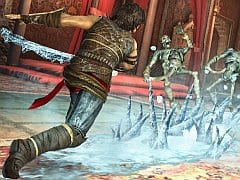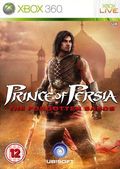You can trust VideoGamer. Our team of gaming experts spend hours testing and reviewing the latest games, to ensure you're reading the most comprehensive guide possible. Rest assured, all imagery and advice is unique and original. Check out how we test and review games here
Last week we sat down with Jan-Erik Sjovall, animation director on Prince of Persia: The Forgotten Sands. Read on to hear his thoughts on the Prince’s changing style, the problems with film-to-game adaptations, and why George Lucas is beyond comprehension.
Q: It’s great that you guys are showing off a later level today. I found it quite challenging, but then that’s what the game is, right?
Jan-Erik Sjovall: It gets even harder! [laughs]
Q: How much harder?
JES: It gets very much harder than that! But there’s always a path. It’s not just for hardcore gamers, but we’re banking on the learning curve, that you’re getting comfortable, over the maps, with the way you’re playing. Fighting will stay within certain types of level, new challenges will be posed, boss fights will be put in there, but with the acrobatics… the idea is that with every map, you introduce something new. If we were to keep it all on a certain level, it would get boring very quickly. So we have what we call these epic moments, kind of the “wow” moments where it’s like, “Holy shit, I just figured it out! And now you’re throwing this at me.” It’s kinda cool for me to see you guys playing…
Q: It’s certainly a lot harder than the last game. At the time, the approach with Prince of Persia 2008 seemed quite bold – the whole “no dying” thing. It didn’t hand-hold, exactly, but it was fairly gentle. What was it that prompted you to say, “screw it, let’s go back to the old way”?
JES: It’s not really “screw it”. I’m still behind a lot of the decisions that were made for 2008 because they were fresh. It was a new approach, and I have no issues having a beautiful woman hold my hands every once in a while. But it was interesting to see the reactions of players, and to hear the feedback. So this time around it was like, “We want to go back to Sands of Time.” And what was Sands of Time? It was challenging, and it was really squeezing you as a player. You were dying quite often. We didn’t want it to be a frustrating experience, so there’s error management through rewind, and what we call “comfort powers”, that help you do certain things. But it was still supposed to be challenging, on the player’s behalf. You asked for it, so here you go: you die, and you die. You will die a lot my friend. You will go to hell.
Q: I’ve got a bad habit of being a bit sloppy with my directional inputs, and while playing the game I’d occasionally find myself running up a wall, rather than along it. I quite like that though, the fact that you have to be precise with your controls.
JES: Well, one thing that’s still being tweaked, even as we speak, is camera-relative controls. As a player, I sometimes have issue with that. You’ve probably learned for yourself with the lever-switches: if you press up [on the pad] you’ll push the lever forward, and if you press down you’ll pull it backwards. To me, that can get quite confusing – I end up pushing left, right, up, down, arrgh! So that’s still being tweaked. They’re doing focused tests to figure out what makes sense – we play the game a little too often so it’s good to see a fresh approach to it. Camera-relative controls were already in POP 2008, and I really couldn’t get into them. But like I said, the camera in today’s build isn’t final, so you’ll see some changes.
Q: Prince of Persia 2008 was very well received. Are you turning your back on that way of doing things, on that approach to the franchise?
JES: No. I’m not sure what the plans are, but I know that Ubisoft is still standing behind that game. We’re just trying to do something that was the original plan, to next-gennify the original trilogy. It comes at a convenient time, I’d say, but it was the original plan to do this. It’s just basically been pushed with the convenient release date, it means nothing for the other title. We have to look at how many Prince of Persia and Assassin’s Creed, similar types of adventure title can be in our catalogue. I’m an animation director, that’s way beyond my thing. But it’s a business decision, they have to figure out what they want to do with the IP.
Q: So we could see another similar game?
JES: It’s not abandoned. What I liked about Prince of Persia 2008 was that it appealed to women a lot. We have to bring more women into the games industry, it’s a male audience. And then all of a sudden you have a game like Prince 2008 where all the female journalists, all the female gamers come out and say “I love this game!”. How is it that males don’t like this game? It’s bizarre. The gaming industry has nothing really controversial going on, but that was close. It was polarising the audience. But this [Forgotten Sands] is definitely not doing that. It’s just a step back to Sands of Time. We’ve tried to upgrade the gameplay, to learn the lessons from the last six or seven years – because you can’t just bring the old game back and think it’s going to work.
Q: Do you think that’s something that’s long overdue – the idea that we need to make more games that appeal to women?
JES: Women are not necessarily as competitive as men are, and most games are competitive. Most games cater to two basic emotions: fear and violence. And that’s not necessarily what women are up to. If you have a game that just caters to these types of things, then even to me it’s not particularly appealing. I have a really stressful job, and when I come home I don’t really want to shoot people’s heads off or raise my blood pressure through something else! Prince 2008 is kind of cool, a Christmas fairytale where the world is falling apart and there’s a glimmer of hope. You get to help somebody in their quest to bring hope to the world, to heal the world. It was a totally different approach, a positive message. And then all of a sudden there were these people smashing the game, saying it was total crap. There’s crap all around you, people literally blowing themselves up around you, then you go home and blow people up. So that was interesting, to me. It was a bit depressing, but it was also good to see that so many other people liked it.
Q: Across the original trilogy, and leading up to the 2008 game, the Prince himself went through quite a few changes in appearance. In Sands of Time he was very much the traditional Prince, then he was a bit aggro for the second game, with the heavy metal guitars…
JES: [laughs] It’s the same art director [Mickael Labat]! It was the same art director for Warrior Within, with the aggro heavy metal feel, and for Prince 2008. That’s what I call range!
Q: So, is it just based on the mood he’s in at the time?
JES: I don’t know. If you look at him, he’s more the aggro heavy metal type! But he can do other styles. We also want to establish games as an art form, so that you have a broader range than just photo-realism.
Q: This Prince feels closer to the original…
JES: We definitely wanted him to be closer to the Warrior Within style. And funnily enough, when you look at Jake Gyllenhaal and his look in the movie… Warrior Within! We thought that was hilariously funny. The Warrior Within and Two Thrones style was the better-looking Prince, rather than the guy with the poofy pants, so we wanted to go for that. It’s funny to also see the guys from the film look at the art direction from the game and take that.
Q: Are you glad that you don’t have to make the game tie-in with the film?
JES: Yes. I worked on one of the biggest film franchises, and it was a disaster. I worked on The Matrix: Path of Neo, and it was close collaboration with Warner Bros and the Wachowski brothers. It’s tough. The convergence between films and games is not yet completed, so if you have someone who controls the franchise you have to always report back. Sometimes in game design you have to make quick decisions in order to go forward in the development, and when you’re blocked by a franchisee or licensee, it becomes really tough. Sometimes they say, “No, we don’t like this,” and suddenly you have to make decisions that make the game turn out poopy. If you look at the games that were made to tie in with films… I mean, look at Batman: Arkham Asylum. Where did that come from? All of a sudden you have a superhero game that’s awesome. Normally they’re crap! And it’s the same thing with film tie-ins. There are just a few games that are good, or that review really high. Ubisoft basically said, “We own the game license.” I think it probably has been awesome to work with Disney on this, but if we were to have made something based on the film, I’m not sure if we’d have even finished on time. It’s tough to do that back-and-forth with film. It’s really tough.
Q: The consensus seems to be that limited development time is always the issue with movie-to-game adaptations. Is it that simple?
JES: I think so. It would be great if someone said, “what is it that you want to achieve with the game that ties in with the film?” You want to give people the ability, so that after they’ve seen a movie they can go home and re-play all the epic moments in the film. Now, a film is not made like a game, and a game needs to have certain things in place in order to make it fun. Like, what is the gameplay mechanic? The best example for me is always… what was George Lucas thinking with that one moment in Star Wars? There’s that bit where they go this one planet, when they go to the big factory [in Attack of the Clones] and C-3PO and R2D2 land on a conveyor belt and have to move along. That was like a game! It’s a film taking a game mechanic, of two characters having to platform. That wasn’t working for me, as an audience for a film. I’m interested to play this, but I’m not interested to see it.
Q: I don’t think you’re alone there…
Prince of Persia: The Forgotten Sands is due for release on PS3, Xbox 360, PC, Wii, DS and PSP in May.
Prince of Persia: The Forgotten Sands
- Platform(s): Nintendo DS, PC, PlayStation 3, PSP, Wii, Xbox 360
- Genre(s): Action

/https://oimg.videogamer.com/images/3b20/pop_the_forgotten_sands_12.jpg)
/https://oimg.videogamer.com/images/4f4d/pop_the_forgotten_sands_11.jpg)
/https://oimg.videogamer.com/images/1782/pop_the_forgotten_sands_10.jpg)






